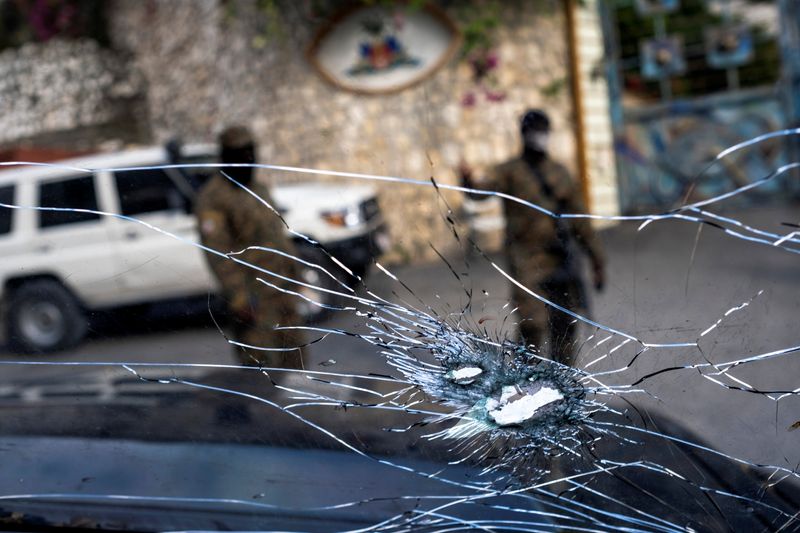(Reuters) -Haitian President Jovenel Moise was shot dead when assassins armed with assault rifles stormed his private residence in the hills above Port-au-Prince on July 7.
The assassination triggered an international manhunt.
Here is what we know so far:
HOW WAS MOISE KILLED?
A large group of gunmen killed Moise, 53, in an early morning attack on his residence in Petionville, a northern, hillside suburb of the capital Port-au-Prince. His wife was wounded but survived.
The gunmen were disguised as U.S. Drug Enforcement Administration agents, a ruse that helped them enter Moise’s home with no resistance from his security detail, authorities have said.
WHAT HAPPENED TO THE GUNMEN?
The gunmen fled but the police tracked some of them to a house near Moise’s residence, where a firefight lasted late into the night.
The group included 26 Colombians. So far 18 of the 26 have been detained, while three were killed by police and five are still on the run. Police have also arrested two Haitian Americans.
WHO WERE THE COLOMBIAN HITMEN?
The Colombian government says the men suspected of taking part in the assassination were retired members of the armed forces.
Many of the former Colombian soldiers went to Haiti to work as bodyguards, but others knew a crime was being planned, according to Colombia’s president.
At least six of the men had received U.S. military training in the past while serving as active members of the Colombian military, the State Department said.
WHO ARE THE MASTERMINDS BEHIND THE ATTACK?
It remains unclear who planned the murder, and with what goal.
Ex-Haitian justice ministry official Joseph Felix Badio may have ordered the assassination three days before the attack, giving the orders to former Colombian soldiers Duberney Capador and German Rivera, according to Colombian police chief General Jorge Vargas. Badio’s whereabouts are unclear.
Authorities have also detained 63-year-old Christian Emmanuel Sanon, widely described as a Florida-based doctor, and accused him of being one of the masterminds behind the killing.
Sanon hired the mercenaries to oust and replace Moise, authorities said. National Police Chief Leon Charles said Sanon flew to Haiti on a private jet in early June, accompanied by hired security guards, and wanted to take over as president.
Charles also identified former Haitian Senator John Joel Joseph as a key player in the plot, saying he supplied weapons and planned meetings, and that police were searching for him.
Charles said Dimitri Herard, the head of palace security for Moise, has also been arrested. Prosecutors want to know why the attackers did not meet more resistance at the president’s home.
WHAT HAPPENS NEXT?.
Moise was on Friday laid to rest in his home town of Cap-Haitien, which was hit by violent demonstrations https://www.reuters.com/world/americas/haiti-presidents-hometown-prepares-funeral-tension-simmers-2021-07-23 in protest at his killing before and during the service.
Moise’s assassination has triggered fresh political volatility in the Caribbean nation of 11 million people, with fears of more violence before new elections that are due to be held in September.
Ariel Henry was appointed as Haiti’s prime minister on Tuesday, with the aim of bringing stability before the elections, backed by the United States and the international community.
U.S. investigators continue to assist Haitian authorities with their probe.
The United States may also bring charges in a U.S. court, if possible, against those who killed Moise, a senior U.S. administration official has said.
The United States also announced a special envoy to help coordinate U.S. assistance in Haiti, including efforts promoting long-term peace and elections.
(Compiled by Anthony Esposito in Mexico City; Editing by Drazen Jorgic and Rosalba O’Brien)























